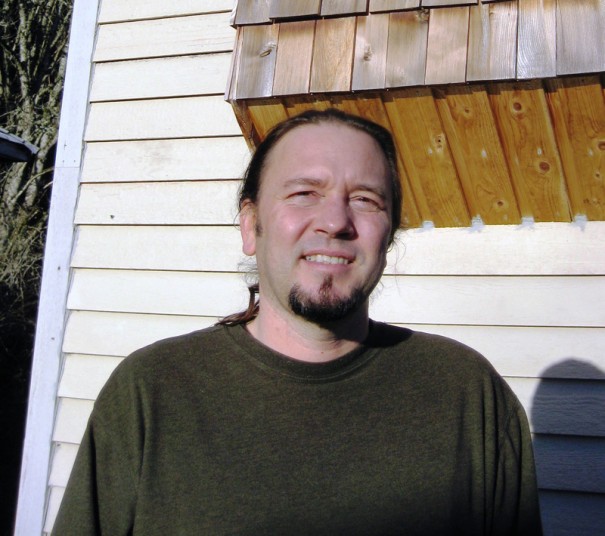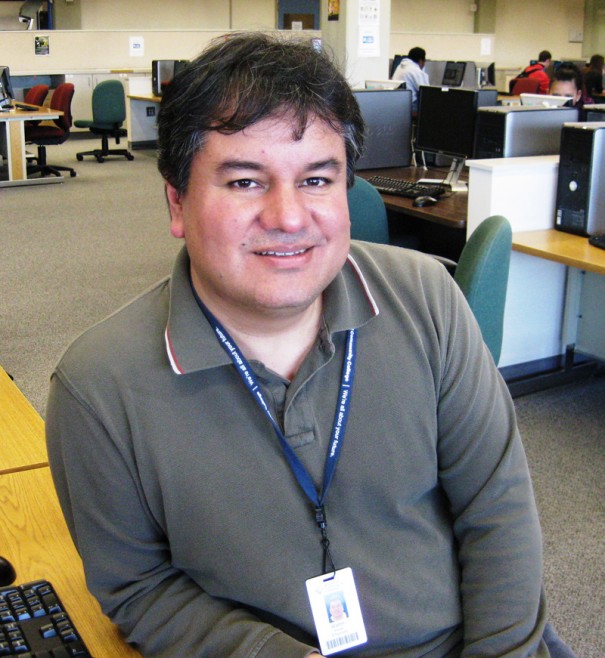This content was published: February 8, 2011. Phone numbers, email addresses, and other information may have changed.
Rock Creek Faculty Ensure Voices are Heard for Campus Improvements
Photos and story by Christine Egan
Following voters’ approval of the PCC bond measure in 2008, leaders at Rock Creek challenged themselves to develop a planning process that fully involved campus stakeholders in creating a campus design that effectively meets the needs of Rock Creek students, faculty and staff.

Shannon Baird is a member of the Rock Creek Campus Bond Internal Steering Committee (BISC) and Co-Chair of the Building Construction Technology Department at Rock Creek Campus
Though many volunteered, two faculty members took on a major leadership role: Shannon Baird, Department Co-Chair for Building Construction Technology and Walter Morales, Department Chair for the Computer Science Department. Both faculty members signed up early to serve on the Bond Internal Steering Committee (BISC), a group comprised of Rock Creek Campus President, David Rule, deans, managers, faculty, staff and district leadership.
While both Baird and Morales are motivated by the opportunity to improve Rock Creek campus, the two stakeholders have approached their charge differently – both with success. Morales, a soft spoken paragon of patience, explains, in his melodic Brazilian accent that he joined the committee to provide a communications link between campus faculty and the bond program staff. Baird, on the other hand, views his role as an advocate for Rock Creek staff, faculty and students to understand and participate in the planning process. His philosophy is that, “while the squeaky wheel may not always get the grease, you still have to squeak.”

Walter Morales is a member of the Rock Creek Campus Bond Internal Steering Committee (BISC) and the Chair for the Computer Science Department at Rock Creek
After joining the committee, Morales was drawn to a BISC subcommittee focusing on the design of campus “Spaces and Clusters.” “Spaces” include designated classrooms, labs, dining halls and student centers; “Clusters” refer to informal spaces – nooks and crannies – where students study or hang out between classes. “I have seen good and bad classroom setups, and I wanted the Computer Science Department to have a say,” Morales said. Morales admits he has never been involved with such a large project before. “I had no idea what the process and outcome were going to be.” Initially he was overwhelmed by the complex nature of topics such as building placement, surface water runoff and traffic flow, to name a few. “I thought we would just be building buildings. It was very interesting,” he conceded.
Baird knew differently. With his architectural background and construction experience, his learning curve was less steep. Baird’s expertise helped him embrace the process, engage with the bond project manager, Opsis Architecture and other campus constituents, and narrow the divide between experts and stakeholders. “I see my role as helping the campus communities find their voice, and then, helping them scream.” Early on, Baird posted flyers around campus announcing bond meetings and activities. Later in the process, he supplemented outreach conducted by Opsis and the bond team by presenting program option diagrams to department chairs for building 7, where much of the construction will take place. In each case, Baird explained various design options proposed by the team and the committee. “That helped the bond team get enough people participating to get a good sample,” said Baird.
Morales led a different type of outreach by hosting informal drop-in sessions the last week of fall term (2010), which primarily attracted Rock Creek faculty. He also successfully engaged the Faculty Federation, a union that represents full-time and part-time faculty, in the planning discussion. The Federation has drawn attention to issues facing Rock Creek faculty, such as part-time instructors’ need for more space. Another example Morales recalled: “An instructor came to me to say he has transgender students who do not know where to change clothes for his class. I brought this information to the attention of the committee.” Serving as an effective conduit between faculty and the design team has positioned Morales as a valuable point person for those who will be directly affected by campus construction, program and classroom placement.
Thanks in large part to the efforts of Baird and Morales, an increasing number of campus stakeholders will participate in the next phase of planning and design. The campus bond project team is recruiting people to serve on newly formed committees addressing topics such as the West Campus Zone, learning spaces, career technical programs, health and wellness, student development and interfaces, multidisciplinary and campus climate.
“Committee work has allowed people to develop ideas and build on each others’ ideas,” said Baird. For instance, “No one thought we’d be renovating building 7 again, but when we started looking at it in terms of parking, energy used, building toward the center of campus and usability of the quad space . . . it made sense. I have fielded several questions about the loss of the building 7 atrium, which uses more energy than any other room in the district. I was able to talk to the architects as one voice, to let them know how important it will be to recreate that experience in the new building.”
As Morales sees it, “Rock Creek is our home. We want to have a say in what our home will look like.”


Very nice. Great job and nice pictures.
Narce
Hi
New buildings are nice, but without added parking we the students will still be playing the game of driving down the aisles looking for a parking space. I first attended PCC back in 1983. Parking was a problem then and its still a problem today. I watch people drive sometimes as long as thirty minutes looking for a space. How about some Parking Spaces!
Thanks….
Thank you for visiting the Bond web site and taking time to write us. You are correct. Parking is an issue. Parking spaces lost to new buildings will be recovered. However, simply adding more parking spaces will not adequately respond to the issue. Not only are there limitations on the number of parking spaces the college is permitted to put on each of its campuses, there is a desire to find working alternatives to driving alone, to institute effective tools and options to manage the demand for parking at each campus (such as additional shuttle service, improved ridesharing, additional bike parking, incentives and also disincentives), and to reduce our carbon foot print and meet the goals outlined in the college CLIMATE ACTION PLAN (http://www.pcc.edu/about/sustainability/documents/FINALCLIMATEACTIONPLAN.pdf [pdf] ).
The college is working with a team of consultants to help identify what tools and options would work best throughout the district and on each of the campuses. In the beginning of the Spring term students, staff and faculty will be asked to partake in a transportation survey that will provide valuable information about how and when people move throughout the district, what thresholds people have for using alternatives, as well as much more information. We know the bond program has been asking everyone to participate in a lot of surveys of late, but they are key to discovering and informing bond funded improvements slated throughout the college. There are activities, committees, open houses, web information and forums and other information outlets on each of the campuses. Please stay involved. Your input is critical. Thanks again for writing.
Nice review of the subject , I was looking to understand this matter further and found this information to be very good.